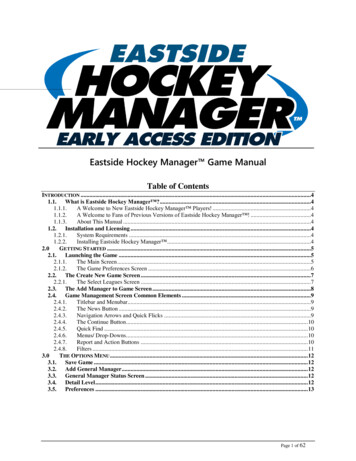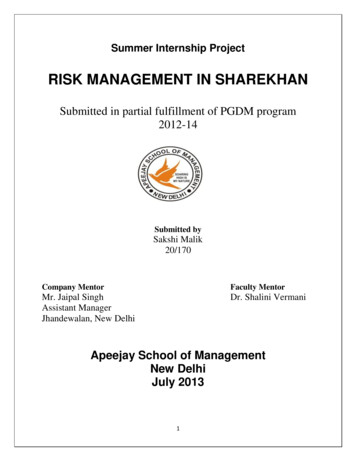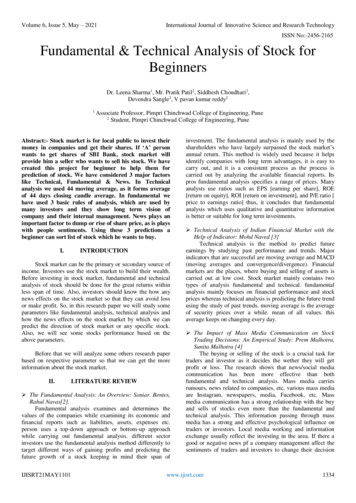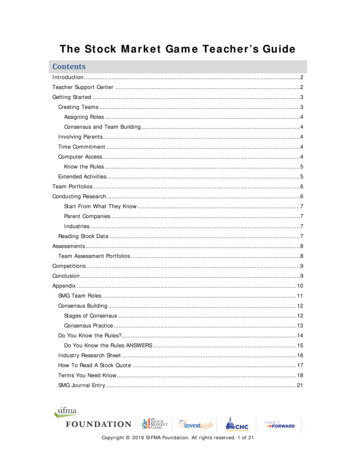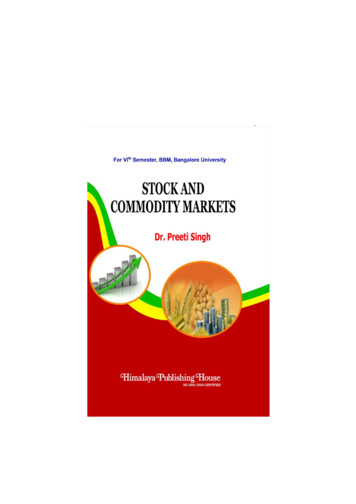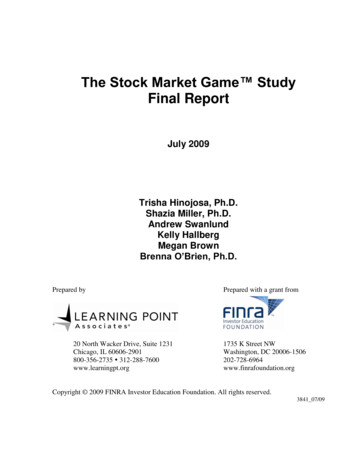
Transcription
The Stock Market Game StudyFinal ReportJuly 2009Trisha Hinojosa, Ph.D.Shazia Miller, Ph.D.Andrew SwanlundKelly HallbergMegan BrownBrenna O’Brien, Ph.D.Prepared by20 North Wacker Drive, Suite 1231Chicago, IL 60606-2901800-356-2735 312-288-7600www.learningpt.orgPrepared with a grant from1735 K Street NWWashington, DC ight 2009 FINRA Investor Education Foundation. All rights reserved.3841 07/09
Learning Point AssociatesLearning Point Associates is a nonprofit education consulting organization with 25 years ofdirect experience working with and for educators and policymakers to transform educationsystems and student learning. Our vision is an education system that works for all learners, andour mission is to deliver the knowledge, strategies, and results so educators will make researchbased decisions that produce sustained school improvements throughout the education system.We are known for the work we do:Designing and conducting client-centered evaluations.Analyzing and synthesizing education policy trends and practices.Delivering high-quality professional services directly to our clients.Conducting rigorous and relevant education research.Learning Point Associates manages a diversified portfolio of work ranging from directconsulting assignments to major federal contracts and grants. Our national and internationalreputation is built on a solid foundation of conducting applied research as well as developing anddelivering tools, services, and resources targeted at pressing education issues and challenges.Key to our success is the ability to collaborate productively with other organizations, forgingstrategic alliances for added value and efficiency.With offices in Chicago and Naperville, Illinois; New York; and Washington, D.C., LearningPoint Associates employs a professional staff of 150. The staff is a balanced mix of specialtyconcentration, technical expertise, and management and leadership ability. We also maintain adiverse network of external consultants and subcontractors.Evaluation Services at Learning Point AssociatesKnowledge is the cornerstone of effective change. At Learning Point Associates, we use our 25years of experience in evaluating education programs and policies and researching critical issuesto ensure that educators have solid, accurate information to drive their decision making. Ourclients—including state education agencies, school districts, foundations, and the U.S.Department of Education—can trust that our approach to evaluation is thorough andmethodologically sound and that their needs will drive each step of the evaluation process.Decision makers at all levels of the education system have used our evaluation services to assessand improve system performance overall and in critical areas such as afterschool services,district and school improvement, literacy, and educator quality.For additional information on evaluation at Learning Point Associates, please contact LarryFriedman, Ph.D., chief program officer, Evaluation, by phone (312-288-7626) or e-mail(larry.friedman@learningpt.org).
FINRA Investor Education FoundationThe FINRA Investor Education Foundation supports innovative research and educationalprojects that give underserved Americans the knowledge, skills and tools necessary for financialsuccess throughout life. Since its inception in December 2003, the foundation has approvedapproximately 46 million in financial education and investor protection initiatives through acombination of grants and targeted projects. For details about grant programs and other FINRAFoundation initiatives, visit www.finrafoundation.org.FINRA, the Financial Industry Regulatory Authority, is the largest non-governmental regulatorfor all securities firms doing business in the United States. FINRA is dedicated to investorprotection and market integrity through effective and efficient regulation. FINRA registers andeducates industry participants, examines securities firms, writes and enforces rules and federalsecurities laws, educates the investing public, and provides trade reporting and other industryutilities. FINRA also administers the largest dispute resolution forum for investors and registeredfirms. For more information, please visit www.finra.org.
CONTENTSExecutive Summary . 1Methodology . 1Study Instruments . 1Sample . 2Study Results . 2Introduction . 6The Stock Market Game . 6Research Questions . 7Study Methodology . 9The Randomized Controlled Trial . 9The Nationwide Teacher Survey . 10Data-Collection Instruments . 11Study Attrition . 22Findings . 26Psychometric Analysis of Instruments . 26Impact on Student Achievement . 27Teacher Implementation of The Stock Market Game . 38Student Experiences of The Stock Market Game . 59The Relationship Between Teacher Implementation and Student Experience . 73Effect of Implementation on Student Learning . 80Effect on Teacher Investment Practices . 85Conclusions . 94References . 96AppendixesAppendix A. Characteristics of Treatment and Control Groups . A1Appendix B. Psychometric Analysis . B1Appendix C. Estimating the Impact of Playing The Stock Market Game . C1Appendix D. Teacher Survey Analysis . D1Appendix E. Student Survey Analysis . E1Appendix F. Analysis of Teacher Implementation and Student Experience . F1Appendix G. Statistical Modeling of Implementation, Experience, and Learning . G1
ACKNOWLEDGMENTSMany individuals and organizations contributed to the study of The Stock Market Game. Inparticular, our deep appreciation goes to the FINRA Investor Education Foundation for itsfinancial support of the study.From the Securities Industry and Financial Markets Association (SIFMA) Foundation forInvestor Education, we received invaluable guidance in understanding the program andgracious support in conducting the study. We greatly appreciate the help and cooperationwe received from Kathy Floyd, Karla Helgans, Vincent Young, and Frank DeStefano.We value the expert guidance we received from James Kemple on questions ofmethodology, Ching-Fan Sheu on statistics, Everett Smith on psychometrics, and LarryOsthus and Ellen Viruleg on developing content and age-appropriate mathematics tests.At Learning Point Associates, Chloe Gibbs and Ayrin Molefe imparted valuable input atcritical junctures; Jennifer Schroll developed and maintained the data-collection databases;and Larry Friedman provided unstinting support and astute advice.
EXECUTIVE SUMMARYThe Stock Market Game is an educational program supported by the Securities Industryand Financial Markets Association (SIFMA) Foundation for Investor Education. Theprogram is designed to teach students the importance of saving and investing throughbuilding their financial literacy skills. Students manage fantasy investments online,competing against other individuals and teams both in their classroom and around theworld. To supplement the hands-on game play, The Stock Market Game provides teacherswith a series of unit-based lessons to assist with student learning.The FINRA Investor Education Foundation made a grant to Learning Point Associates toconduct a study of the impact of the game on students and teachers. Specifically, the studywas designed to answer four research questions:1. What is the impact of The Stock Market Game on academic achievement inmathematics for students in Grades 4–10?2. What is the impact of The Stock Market Game on investment knowledge forstudents in Grades 4–10?3. How do teachers implement The Stock Market Game?4. What is the effect of The Stock Market Game on teacher investment practices?MethodologyDuring the 2008–09 school year, Learning Point Associates conducted a randomizedcontrolled trial (RCT) and surveyed teachers of The Stock Market Game nationwide. TheRCT examined the causal impact of playing the 10- or 15-week versions of The StockMarket Game on student mathematics achievement and investor knowledge. Thenationwide survey provided information on implementation of the game and teacherinvestment practices. Prior to the study, data-collection instruments were developed,administered, psychometrically evaluated, and, where appropriate, revised. Afterimplementation of the RCT, final data were analyzed (1) psychometrically to createsummarized scale scores and (2) statistically using hierarchical linear modeling to measureprogram impact and implementation.Study InstrumentsFour types of instruments were developed for the study. These instruments included severalage-appropriate student versions.Mathematics test (Grades 4–6, Grades 7–10)Investor knowledge test (Grades 4–5, Grades 6–8, and Grades 9–10)Student survey (Grades 4–6, Grades 7–10)Teacher surveyLearning Point AssociatesThe Stock Market Game Study: Final Report—1
The mathematics and investor knowledge tests included pretest and posttest versions,administered before and after a 10- to 15-week game session. The mathematics tests werebuilt from publicly available items from the National Assessment of Educational Progress(NAEP) and assessed concepts related to the content of The Stock Market Game. Theinvestor knowledge tests were developed with the help of experts in the area of testingfinancial literacy and aligned to the curriculum content of The Stock Market Game.The student surveys were designed to measure students’ engagement with the game, howmuch students enjoyed and learned from interacting with each other, their development offinancial life skills, and the application of student learning outside the classroom.The teacher survey was designed to measure how teachers implemented the game and toprovide a profile of teacher investment practices. Measurement of the game’simplementation focused on teacher classroom activities, use and helpfulness of gamerelated materials, and whether teachers connected the game to events in the outside world.Measurement of teacher investment practices focused on the influence of teaching TheStock Market Game on engaging in financial planning, conducting financial research, andusing investment products and services.SampleIn the months before the study, teachers who were currently registered for The StockMarket Game for the upcoming school year or who had previously registered were invitedto participate in the RCT. Approximately 1,200 teachers signed up to participate. Of these,823 teachers were selected to be a part of the study (based on the grades they would beteaching and the length of the game session). Approximately half the sample was randomlyassigned to use The Stock Market Game in their classrooms in the fall of 2008 (thetreatment group), and the other half was assigned not to use the program (the controlgroup). Not all 823 teachers participated in the study; 568 teachers confirmed participation(296 treatment and 272 control).Of the 568 teachers who confirmed participation in the study, 555 submitted student testdata. For the investor knowledge test, 522 submitted data (269 treatment and 253 control);for the mathematics test, 509 submitted test data (265 treatment and 244 control). Inaddition, 187 treatment classrooms submitted student survey data (the student survey wasnot requested of control classrooms).All teachers who have registered for The Stock Market Game were invited to take theteacher survey. Approximately 11,800 teachers were invited, and 4,804 teachers completedthe survey (including responses from 230 treatment teachers and 229 control teachers).Study ResultsThe study of The Stock Market Game and the nationwide administration of the teacher survey:yielded findings on the following measures:The impact of the program on student achievement2—The Stock Market Game Study: Final ReportLearning Point Associates
Student experiences playing the game as well the effect of those experiences ontheir academic achievementTeacher implementation of the program and the effect of implementation on studentlearningTeacher perceptions of the effect of teaching the game on their own investmentpracticesImpact on Student AchievementOverall, results from the RCT showed that students who played The Stock Market Gamesignificantly outperformed students who did not play the game on both the mathematicsand investor knowledge tests.Mathematics achievement was analyzed separately for students in Grades 4–6 and studentsin Grades 7–10.1 For students in Grades 4–6, those in the treatment group scoredapproximately 27 points higher than those in the control group. This difference isequivalent to an effect size of 0.25, with a confidence interval ranging from 0.11 to 0.40.For students in Grades 7–10, the treatment group scored approximately 15 points higherthan the control group. This difference is equivalent to an effect size of 0.17, with aconfidence interval ranging from 0.02 to 0.32.Figure 1. Average Score on Mathematics Testsfor Treatment and Control GroupsEffect size 0.25525Effect size 0.17517508Scale Score505493490485465445425Grades 4-6TreatmentGrades 7-10ControlAnalysis of students’ investor knowledge was carried out separately for students in Grades4–5 (elementary school), 6–8 (middle school) and 9–10 (high school). For students in1Several modeling approaches were used in order to support the findings from the treatment-on-the-treated model.See full report for details.Learning Point AssociatesThe Stock Market Game Study: Final Report—3
elementary school, the treatment group scored approximately 62 points higher than thecontrol group, corresponding to an effect size of 0.43 with a confidence interval rangingfrom 0.24 to 0.61. For students in middle school, the treatment group scored approximately42 points higher than the control group, corresponding to an effect size of 0.45 with aconfidence interval ranging from 0.29 to 0.60. For students in high school, the treatmentgroup scored approximately 36 points higher than the control group, corresponding to aneffect size of 0.39 with a confidence interval ranging from 0.16 to 0.62.Figure 2. Average Scores on Investor Knowledge Testsfor Treatment and Control GroupsEffect size 0.43550Effect size 0.39538530Scale ScoreEffect size dle SchoolTreatmentHigh SchoolControlStudent ExperiencesMost students reported that they enjoyed, and learned from, playing The Stock MarketGame. Students reported that playing on a team during The Stock Market Game was apositive experience that led to improvement of educationally relevant skills, such asconflict resolution, communication, and the development of financial life skills. Somestudents also reported engaging in activities outside the class that related to topics coveredby the game.More than 75 percent of students reported that they enjoyed playing The Stock MarketGame and that they enjoyed specific activities, such as selecting companies to invest in andtrading stocks on the computer. Most students also reported that they enjoyed playing on ateam and that playing led to the development of other skills such as better communication,compromise, and conflict resolution. More than half the students agreed that playing TheStock Market Game influenced them to think more about budgeting and financial planning.Some students also reported taking the experience of The Stock Market Game outside theclassroom, such as by talking to friends and parents about the game and watchingtelevision programs containing financial content.4—The Stock Market Game Study: Final ReportLearning Point Associates
Looking at student experience in relation to student learning yielded some interestingresults. Middle and high school students who reported greater engagement with the gametended to have higher scores on the investor knowledge tests than students who were lessengaged with the game. This was not true, however, for elementary students. Students inmiddle and high school who reported more enjoyment and learning from interactions withtheir team members and classmates tended to have lower investor knowledge scores. Therewere no significant relationships between student experience with the program andperformance on mathematics assessments.Teacher ImplementationTo implement the program, most teachers used basic teaching practices that are easy toincorporate into daily classroom activities. More than half the teachers surveyed reportedusing typical classroom activities such as introducing basic concepts, using worksheets,and discussing current events and careers related to the stock market. In addition, someteacher reported using more advanced activities such as playing the game with students,assigning game-related projects, inviting guest speakers to class, and taking field trips withthe students.Greater teacher implementation of The Stock Market Game had minimal relationship withscores on the mathematics assessment; greater implementation was, however, associatedwith higher investor knowledge scores for middle school students. In addition, severalmeasures of the more specific elements of teacher implementation were related to greaterstudent learning.Teaching The Stock Market Game with a greater breadth and depth of practices was foundto be related to the following experiences for the younger students: stronger engagementwith the game; stronger positive interactions with classmates; and greater extension oflearning beyond the classroom. In addition, teaching The Stock Market Game with moreadvanced methods of linking the game to outside resources was important to theexperiences of older students, leading to greater extension of learning beyond theclassroom.Teacher Investment PracticesOverall, more than half the teachers surveyed reported engaging in financial planningpractices, conducting financial research, and using investment products and services. Forsome of these teachers, The Stock Market Game influenced these practices.At least 75 percent of teachers reported engaging in financial planning practices (e.g.,setting financial goals and analyzing their risk tolerance), and more than half the teachersreported conducting financial research (e.g., reading the business section of the newspaperand subscribing to a financial magazine) and using investment products and services (e.g.,opening an investment account and investing in the stock market). For all the activitiesrelated to financial practices, research, and products, between 28 and 62 percent of teachersreported The Stock Market Game had a moderate or major influence on their doing so.Learning Point AssociatesThe Stock Market Game Study: Final Report—5
INTRODUCTIONLearning Point Associates was awarded a grant by the Financial Industry RegulatoryAuthority (FINRA) Investor Education Foundation2 to conduct a study of the effect of TheStock Market Game on students and teachers. This report details this study by first giving abrief description of The Stock Market Game, then a discussion of the study methodologyand the findings.The Stock Market Game The Stock Market Game is an educational program supported by the Securities Industryand Financial Markets Association (SIFMA) Foundation for Investor Education.3 Theprogram is designed to teach students the importance of saving and investing by buildingtheir financial literacy skills. It is currently in use in all 50 states in North America andaround the world and has been played by more than 11.5 million students.The Stock Market Game centers on teams of students managing real-time virtual (Internetbased) investments. Students use research and program-provided news updates to invest ahypothetical 100,000 in a portfolio, which simulates the results of their investments asthough it were in the real marketplace. The program offers several game sessions in the falland spring of each school year, most of which are 10 to 15 weeks in duration, with somethat run for the full academic year. During these sessions, students compete with teams intheir classroom and teams in their states to increase the value of their portfolio. Thiscompetition adds to the appeal of the program for many students as well as provides theopportunity to build interpersonal skills, such as leadership and negotiation.To supplement teaching about the stock market, saving, and investing, the programprovides teachers with a series of unit-based lessons. The lessons build on four units:(1) Before You Invest, (2) Selecting Your Investments, (3) Tracking Your Investments, and(4) At the End of the Trading Session. Composing the units are 12 core lessons coveringessential financial and investment topics, including company, stock, ticker, and risk. Eachof these lessons is designed to provide students with the skills and knowledge that willenable them to be smart future consumers in the savings and investment markets. Inaddition to the core lessons, the program provides noncore lessons and projects, whichallow teachers to extend the program beyond the basic implementation.The Stock Market Game also allows for teachers to differentiate the program according tothe needs and ability levels of their students. The 12 core lessons are available for variouseducational and developmental levels. There are four age levels of lessons:2Grant number 2007-06-017.3The Stock Market Game was originally overseen by the Foundation for Investor Education, which in 2007 mergedwith The Bond Market Foundation and the New York District Economic Education Foundation to form the SIFMAFoundation.6—The Stock Market Game Study: Final ReportLearning Point Associates
Elementary school (Grades 4–5)Middle school (Grades 6–8)High school (Grades 9–12)PostsecondaryTeachers of all subjects—including mathematics, social studies, and language arts—use thegame, supplementing their course material with a real-world application of the skills theyare teaching. Although all the core lessons are designed to be used in any course, studentsplaying The Stock Market Game in a mathematics class may require different instructionfrom students playing in an economics class. Adaptation is made possible throughadditional activities and projects (such as Math Behind the Market) tailored to the type ofcourse in which the game is to be employed.Research QuestionsThe four research questions addressed by this study can be conceptualized in terms ofvarious degrees of expectation.One expectation of a supplemental education program is that it will improve students’understanding of program-related content and student performance on related assessments.For that reason, it was expected that students who play The Stock Market Game wouldimprove their knowledge of topics related to savings and investing. In addition, a review ofprogram content revealed the mathematical nature of The Stock Market Game, leading toanother possible expectation related to student performance. Namely, could themathematical component of the program material be strong enough to affect students’mathematics skills?Beyond program effect on student performance, the study also aimed at uncovering themultiple facets of teacher implementation. This was done by investigating not only thedegree of teacher implementation but the wide array of teaching practices used to educatestudents about the content of the game.Student experiences were also considered important to understanding this program.Anecdotal reports indicated that students enjoy playing this game, but could there be anyeducational relevance beyond the program content? Specifically, could working withteams, researching stocks, or reviewing investment portfolios have any additionaleducational benefit to students?In thinking through the possible effect of this 15-week supplemental program, anotherquestion surfaced. Although the game is intended to teach students about savings andinvesting, could teaching about savings and investing have an effect on teachers? Couldteaching students about savings and investing actually lead to the development of betterinvestment practices of teachers?Learning Point AssociatesThe Stock Market Game Study: Final Report—7
Therefore, this study, which began in the fall of 2007 and ended in the spring of 2009, wasdesigned to answer the following four research questions:1. What is the impact of The Stock Market Game on student academic achievement inmathematics for students in Grades 4–10?2. What is the impact of The Stock Market Game on student investor knowledge forstudents in Grades 4–10?3. How do teachers implement The Stock Market Game?4. What is the effect of The Stock Market Game on teacher investment practices?8—The Stock Market Game Study: Final ReportLearning Point Associates
STUDY METHODOLOGYThe study of The Stock Market Game consisted of two components: a randomizedcontrolled trial (RCT) and a nationwide administration of a survey to teachers. Beforecarrying out the RCT and administering surveys, instruments were piloted in the spring of2008 to test, revise, and finalize study instruments, as well as to refine logistics related tostudy implementation. Information on the pilot phase is in The Stock Market Game StudyInterim Report, submitted to the FINRA Foundation in September 2008. The interim reportdetails the activities undertaken prior to carrying out the RCT and administering the teachersurvey.The Randomized Controlled TrialThe RCT component of this study began in the spring of 2008 with participant recruitmentand the actual study trial itself occurred in the first academic semester of the 2008–09school year. The purpose was to conduct a study in which causal statements about theimpact of playing The Stock Market Game on student achievement can be made. Tomeasure achievement, two tests were developed: a mathematics tests and an investorknowledge test.4RCT SamplePower analysis indicated that 120 classrooms (60 treatment and 60 control) per test wouldbe needed to detect an effect size of 0.2.5 In order to recruit participants, the research teamdesigned and established a Web-based study sign-up page, and all teachers in the SIFMAFoundation registration database were invited to sign up. This sign-up webpage indicatedonly that teachers who signed up would be considered for the study; it did not indicate thatteachers would participate in the study. In addition, the research team conducted a webinarfor the local state coordinators of The Stock Market Game outlining the research designand study requirements and spoke at their annual coordinator convention.Approximately 1,200 teachers signed up to participate in the study. Of these, 823 met theeligibility requirements (i.e., teaching the 15-week game and having students in Grades 4–10) and were selected to be a part of the study. There were 406 classrooms that wererandomly assigned to play The Stock Market Game (the treatment group) and 417 wereassigned not to play (the control group). Not all teachers assigned actually participated in4To ensure that the tests were age appropriate, five versions of these tests were developed: two versions of themathematics test and three versions of the investor knowledge test. See Data-Collection Instruments section in thisreport.5Power was set to 0.8 with the following assumptions: intraclass correlation 0.10; 25 students per class; alpha 0.05.Learning Point AssociatesThe Stock Market Game Study: Final Report—9
the study.6 Of the 823 who were assigned, 568 teachers confirmed participation (296treatment and 272 control).Of these 568 teachers, 555 teachers submitted student test data. There were 522 classroomstha
The Stock Market Game is an educational program supported by the Securities Industry and Financial Markets Association (SIFMA) Foundation for Investor Education. The program is designed to teach students the importance of saving and investing through building their financial literacy skills. Students manage fantasy investments online,


